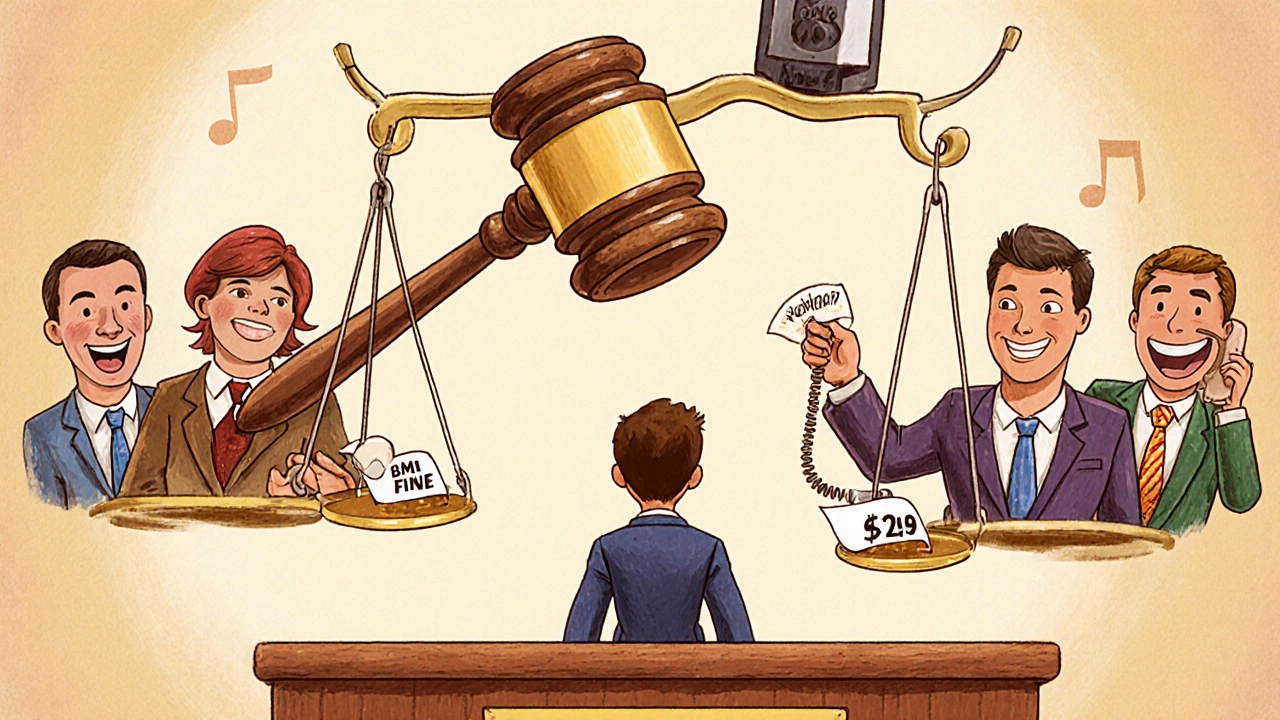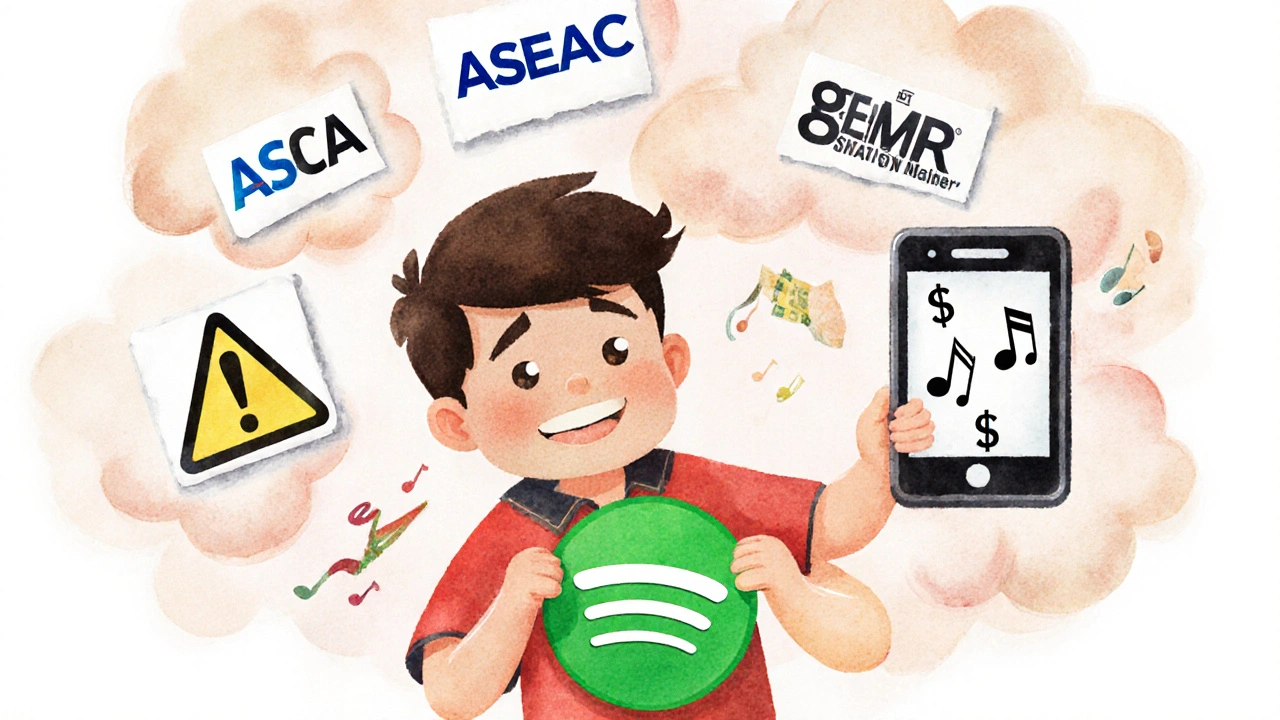Many businesses use music on hold (MOH) to keep callers engaged while waiting. But if you’re using a VoIP system like RingCentral, Microsoft Teams, or 8x8, and you’re playing songs from your personal Spotify playlist, CD collection, or even a radio stream-you’re breaking the law. It doesn’t matter if you paid for the music or have a subscription. Playing music on hold is a public performance under U.S. copyright law, and that requires specific licenses you don’t automatically get when you buy a song or sign up for a streaming service.
Why Your Spotify Subscription Doesn’t Cover MOH
Spotify, Apple Music, Pandora, and other consumer streaming services are designed for personal use. Their terms of service explicitly say you can’t use their music in business settings, especially not over phone lines. Spotify’s Terms of Service, Section 3(c), says their license doesn’t cover “telephony services.” That means even if you’re paying for Spotify Premium or Spotify Business, you’re still not allowed to play songs while someone’s on hold.Companies have been hit with lawsuits over this. A dental office in Ohio got a $12,500 settlement demand from ASCAP after using Pandora for MOH. Another business spent $2,000 fighting a BMI claim after using CDs they bought at Walmart. These aren’t rare cases. According to a 2021 Wall Street Journal report, 78% of small businesses think their music purchases include business rights. They don’t.
What You Actually Need: Two Licenses
To legally use music on hold, you need two separate licenses:- Public Performance License - This lets you play the music to callers over your phone system. This is what ASCAP, BMI, SESAC, and GMR control.
- Reproduction License - This lets you copy the song onto your VoIP system’s server. Buying a song on iTunes doesn’t give you this right.
Most businesses think one license is enough. It’s not. Even if you get a public performance license from a PRO, you still need permission to store the file on your phone system. That’s why uploading a song from your computer to your VoIP system without proper authorization is illegal-even if you own the CD.
Who Controls the Rights? The PROs
In the U.S., four major organizations manage music performance rights:- ASCAP (American Society of Composers, Authors and Publishers)
- BMI (Broadcast Music, Inc.)
- SESAC (Society of European Stage Authors and Composers)
- GMR (Global Music Rights)
These organizations represent songwriters, composers, and publishers. If your music on hold includes a song written by someone represented by any of them, you need a license from that group. There’s no single license that covers all four. You’d need to negotiate separately with each one, which can cost $400-$600 per year per organization. That’s over $2,000 just to cover the basics.
How Licensed MOH Services Solve This
Instead of dealing with four PROs, most businesses use specialized music on hold providers. These companies have already secured blanket licenses from ASCAP, BMI, SESAC, and GMR. They also handle the reproduction rights, so you don’t have to worry about file storage legality.Here’s how it works:
- You pick a service like Easy On Hold or SoundResultsOnHold.com.
- You pay an annual fee (usually $199-$299).
- You get access to hundreds of royalty-free or licensed tracks.
- You download audio files already formatted for VoIP (8kHz, mono, WAV or MP3).
- You upload them to your system-no legal risk.
These services also let you add custom messages. For example, “Thank you for calling. Our office hours are 9 AM to 5 PM, Monday through Friday.” According to Frost & Sullivan, 68% of businesses using professional MOH services include promotional messages. That turns waiting time into marketing time.

What Happens If You Don’t Get Licensed?
The penalties are serious. Each unauthorized performance can cost between $500 and $150,000 under U.S. copyright law. In 2022, PROs filed 147 MOH-related lawsuits-a 32% increase from 2021. Most targets are small businesses that didn’t know they were breaking the law.One business owner in California told Google Reviews: “We used our personal CD collection. Got a letter from ASCAP. Paid $15,000 to settle. We didn’t even know it was illegal.” That’s the reality. PROs aren’t going after big corporations-they’re targeting small businesses because they’re easier to sue and less likely to fight back.
Technical Requirements for VoIP Systems
Even if you get the legal side right, your audio files have to work with your VoIP system. Most phone systems need:- Sample rate: 8kHz (telephone quality)
- Channel: Mono (not stereo)
- Format: WAV or MP3 (some systems like Cisco require .au files)
- Bitrate: Under 128kbps for compatibility
High-quality studio tracks (44.1kHz, stereo) won’t work. They’ll cause delays, distortion, or won’t upload at all. Services like Easy On Hold provide files already optimized for VoIP. If you try to convert a song yourself, you risk poor sound quality or system errors.
Bandwidth usage is minimal-about 64kbps per caller using G.711 codec. But if your audio isn’t properly formatted, the system will re-encode it, which can introduce lag or dropouts. That makes callers hang up faster.
Free Alternatives? Limited and Risky
Some people turn to public domain music-songs where the composer died over 70 years ago. These are legally safe. But the selection is limited. You’re stuck with old classical pieces, ragtime, or folk tunes. Not exactly the vibe for a modern law firm or tech startup.Free music sites like FreeSound.org are tempting, but most tracks there are licensed under Creative Commons, which often still require attribution or prohibit commercial use. If you use a track labeled “CC BY-NC” (Non-Commercial), you can’t use it for business. Violating those terms still leaves you exposed.
And don’t assume YouTube music is free for business use. Even if the video says “no copyright infringement,” the uploader likely didn’t own the rights. YouTube doesn’t verify licensing for MOH use. Relying on it is a gamble.

What VoIP Providers Say
RingCentral, Microsoft Teams, 8x8, and Cisco all make one thing clear in their terms: You are responsible for securing music rights. Microsoft updated its Communications Platform Agreement in January 2023 to explicitly say customers must “obtain all necessary licenses for music played during hold periods.”That means your VoIP provider won’t protect you. They’ll give you the feature. But if you get sued, they won’t cover your legal fees. You’re on your own.
Market Trends and Future Changes
The music on hold market is growing. It was worth $1.2 billion in 2022 and is projected to grow 7.3% annually through 2027. More businesses are realizing the value-not just legal safety, but branding. Companies that use custom MOH with messaging report better caller retention and improved customer perception.Some big changes are coming. ASCAP and BMI are exploring joint licensing for small businesses to simplify things. And by 2025, most experts predict AI-generated MOH will become mainstream-where your hold music changes based on the caller’s location, time of day, or even their industry.
But until then, the rules are clear: If you play music on hold, you need a license. No exceptions.
How to Get Started (Simple Steps)
1. Stop using personal music. Delete any songs you uploaded from Spotify, CDs, or YouTube. 2. Choose a licensed MOH provider. Compare services like Easy On Hold ($299/year) or SoundResultsOnHold.com ($199/year). Both include all necessary licenses and formatted files. 3. Select your audio. Pick tracks that match your brand. Add a 10-15 second message with your hours, website, or promotion. 4. Download the right files. Make sure they’re 8kHz, mono, and in WAV or MP3 format. 5. Upload to your VoIP system. Follow your provider’s instructions (Cisco, 3CX, RingCentral, etc.). 6. Test it. Call your own line. Listen for clarity, delay, and volume.Setup usually takes 2-3 weeks if you’re doing it yourself. Most providers offer free setup help. Use it.
What to Avoid
- Using Spotify, Apple Music, Pandora, or YouTube for MOH
- Playing radio stations over your phone system
- Uploading CDs or MP3s you bought online
- Assuming your VoIP provider handles licensing
- Using “free” music without checking the license terms
If you’ve already used unlicensed music, stop now. Don’t wait for a letter. The cost of a licensed service is a fraction of a single lawsuit settlement.
Is it legal to use music from YouTube on hold?
No. Even if a video says “no copyright claim,” the uploader may not own the rights. YouTube doesn’t verify licenses for business use, and playing music from YouTube over a phone system is considered a public performance. You still need proper licensing from ASCAP, BMI, SESAC, or GMR. Using YouTube music for MOH puts your business at risk of legal action.
Do I need a license if I only play music for 10 seconds?
Yes. U.S. copyright law doesn’t have a minimum time threshold. Whether you play 5 seconds or 5 minutes, if it’s a public performance, you need permission. Even short clips of copyrighted songs require a license. PROs don’t care how long it plays-they care that it was played at all.
Can I use classical music without a license?
You can use classical music only if both the composition and the recording are in the public domain. The composition must be by a composer who died over 70 years ago (like Mozart or Beethoven). But if you’re using a modern recording of that piece-say, from Spotify or YouTube-you still need a license for the recording. Only raw, old recordings from archives like the Library of Congress are truly safe.
What if I use royalty-free music from a website?
It depends on the license. Some royalty-free sites (like AudioJungle or SoundResultsOnHold.com) include public performance and reproduction rights in their license. Others only allow personal use. Always check the license terms. Look for phrases like “commercial use permitted” and “broadcast and telephony included.” If it’s not stated, assume it’s not allowed.
How do I know if my VoIP system supports MOH?
Most modern VoIP systems support music on hold, including RingCentral, 8x8, Microsoft Teams, Cisco, and 3CX. But each system requires specific file formats and settings. Check your system’s admin guide for MOH requirements. If you’re unsure, contact your provider’s support team-they can confirm compatibility and guide you through setup.
